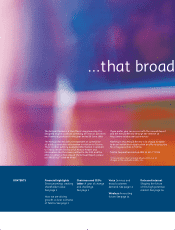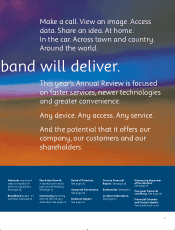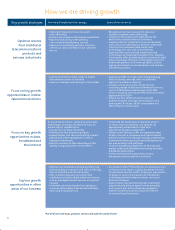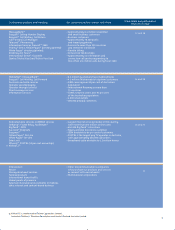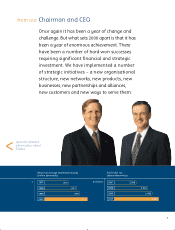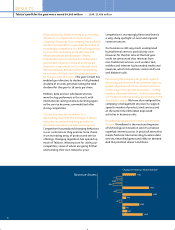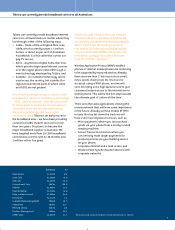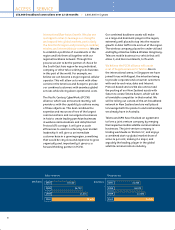Telstra 2000 Annual Report Download - page 9
Download and view the complete annual report
Please find page 9 of the 2000 Telstra annual report below. You can navigate through the pages in the report by either clicking on the pages listed below, or by using the keyword search tool below to find specific information within the annual report.
7
Telstra can currently provide broadband service to all Australians
Telstra can currently provide broadband internet
services to all Australians no matter where they
live through either of the following ways:
• Cable – State-of-the-art hybrid fibre coax
cable, which currently passes 2.5 million
homes, or about 40 per cent of Australian
households. It is this cable that carries our
pay TV service;
• ADSL – Asymmetric Digital Subscriber Line,
which provides high-speed internet services
over the copper phone network through a
new technology employed by Telstra; and
• Satellite – Our satellite technology can be
used across the country, but is perfect for
regional and remote areas or where cable
and ADSL are not present.
One of the key things we seek to achieve with
broadband is, whatever the delivery technology
– ADSL, cable or satellite – that the service will
be transparent to customers. Once people are
connected, there will be little emphasis on
the access technology and more on the
services provided. Telstra is an early mover in
the broadband area – we have been providing
commercial cable modem services for more
than two years. Our plan is to become the
major broadband supplier in Australia. We
have targeted more than 150,000 broadband
connections over the next 12-18 months and
1 million within five years.
Mobiles Growth. Mobiles will soon overtake
fixed line phones in Australia to become the
most widely available voice and data capable
device. Telstra has the leading position in
this market. Our two national digital mobile
networks (GSM and CDMA), with 95 per cent
population coverage, have attracted more
than four million customers.
Wireless Application Protocol (WAP)-enabled
phones or ‘internet mobile phones’ are continuing
to be supported by improved services.Already
there are more than 27 services such as e-mail,
news, sports, share prices etc. that can be
accessed using a WAP phone, and we will
soon be rolling out a high speed service to give
customers instant access to the internet over a
mobile phone. This will be the first step towards
the ultimate goal of ‘online all the time’.
There are other data applications utilising the
mobile network that will have some importance
in the future. Already we have mobile EFTPOS
in taxis. Not too far down the track we will
have even more impressive services, such as:
• ‘Micro payments’ where you can purchase
goods via your phone from a locally located
vending machine;
• Secure Transaction Services where you
can similarly make larger payments for
products/services via your banking service
on your phone;
• Corporate intranet and e-mail access; and
• Wireless Palm Synchronisation devices with
corporate networks.
Revenue %1
1 Revenue change compared to prior corresponding period (i.e. 30/6/99)
Basic Access
Local Calls
STD Calls
International Calls
Mobiles
Fixed to Mobile
Data,text and internet
Directories
Custome r Pre mi ses & Equipment
Intercarrier
Inbound calling
Facilities Management
Other Sales
$2,020m 8.9.
$2,650m (2.8)
$1,406m (5.4)
$987m (10.5)
$2,859m 12.6.
$1,220m (5.3)
$2,838m 14.3.
$1,122m 4.1.
$336m (8.7)
$819m 32.7.
$432m 8.0.
$235m 28.4.
$1,685m 16.7.


